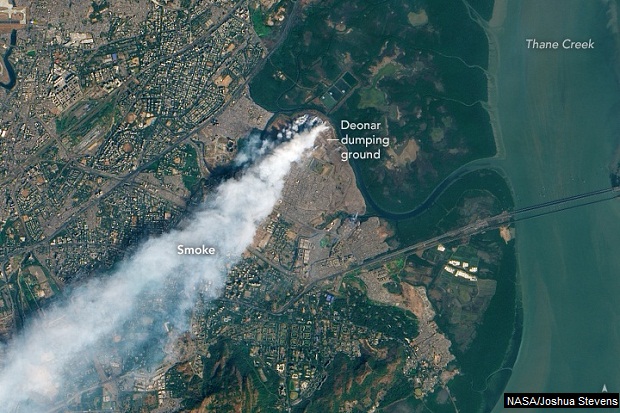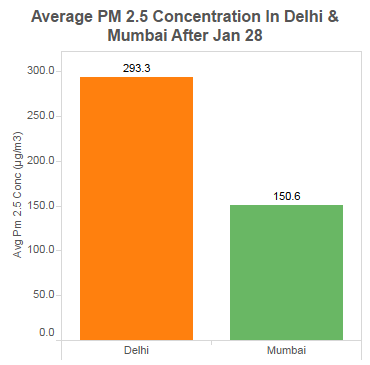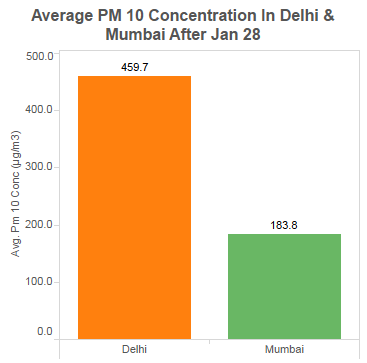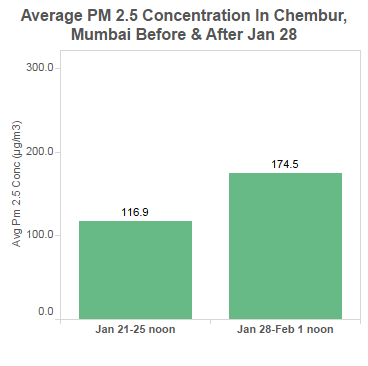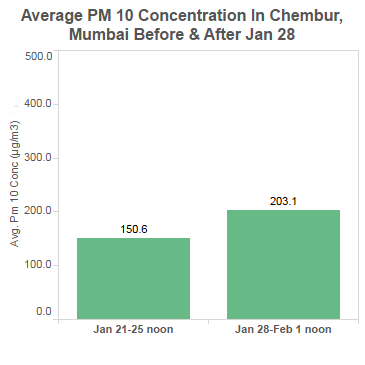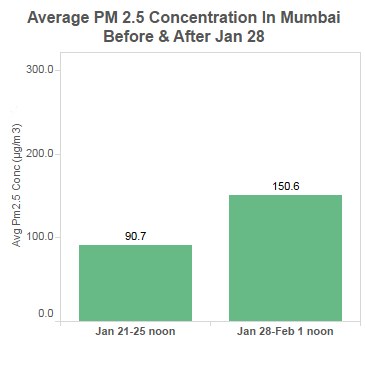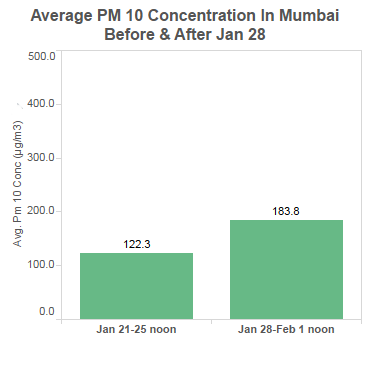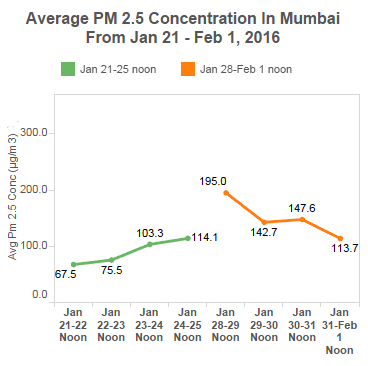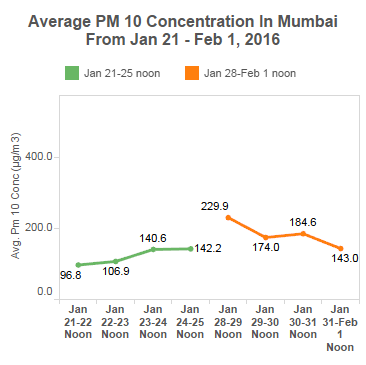Fouled By Trash Fire, Mumbai Air Still 95% Better Than Delhi
Large enough to be seen from space, the fire from a burning garbage dump on Mumbai's eastern edge shut schools, but the city's air-pollution levels were almost twice as good--relatively speaking--as Delhi's, according to data from IndiaSpend's #Breathe air-quality sensors.
The city-wise comparison is based on average data taken over four days from five #Breathe devices across Mumbai (Bandra, Lower Parel, Santacruz, Chembur and Tardeo) and Delhi (Nizamuddin East, Civil Lines, Sukhdev Vihar, Chattarpur and Outram Lines).
The average PM 2.5 level in Delhi was 293.3 µg/m3 (micrograms per cubic metre of air), 95% more than Mumbai's 150.5 µg/m3, between January 28 and February 1, 2016.
Delhi’s average PM 2.5 level was ‘poor’, which could lead to breathing discomfort to most people on prolonged exposure.
Mumbai had a ‘moderate’ reading, causing breathing discomfort to people with sensitive lungs, asthma and/or heart disease.
PM 2.5 are fine particulate matter found in the air with a diameter of 2.5 micrometres or less and are known to pose the greatest risk to human beings. Their measurement is considered to be the best indicator of the health risks from air pollution, according to the World Health Organization.
The average PM 10 (particles between 2.5 to 10 µm in diameter) level in Delhi (495.7 µg/m3) was more than two-and-half times (170% more) that in Mumbai (183.8 µg/m3).
The average PM 10 level in Delhi had a ‘severe’ rating, which affects healthy people and seriously impacts those with existing diseases. Mumbai’s average PM 10 level had a ‘moderate’ rating.
The average PM 2.5 level in Chembur, the area where the fire broke out, was recorded at 116.9 µg/m3 from January 21 to January 25, a week before the fire. The reading surged 49% to an average of 174.5 µg/m3 between January 28 and February 1, 2016, a moderate reading.
Similarly, the average PM 10 level was 150.6 µg/m3 (January 21 to January 25), which increased 35% to 203.1 µg/m3, leading to ‘poor’ conditions, from January 28 to February 1, 2016.
The average PM 2.5 concentration level in Mumbai was 150.6 µg/m3 from January 28 to February 1, an increase of 66% (90.7 µg/m3) over the previous week, between January 21 and January 25.
Similarly, the average PM 10 level rose 50%, from 122.3 µg/m3 (January 21 to January 25) to 183.8 µg/m3 (January 28 to February 1).
Municipal officials claimed to have the fire under control but added it would take "some more time" to douse the fire. About 74 schools were closed for two days (Friday and Saturday). A few stayed shut even on Monday as the situation did not appear to have changed.
Mumbai smog: Government schools in central Mumbai's Shivaji Nagar, Deonar shut as fire at dumping ground rages on for 4 days
— NDTV (@ndtv) February 1, 2016
Note: Figures calculated on 24 hour averages
The graphs show gradual improvement in concentration levels of both PM 2.5 and PM 10 in Mumbai from noon January 28-29 to noon January 31- February 1, as the fire was tamed over these days, indicating improving air quality.
Air pollution: The silent killer
Outdoor air pollution causes 670,000 deaths annually in India, according to this 2014 research paper from the Indian Institute of Management, Ahmedabad.
The relative health benefits of reducing pollution are higher for cleaner cities, such as Shimla, against cities with dirtier air, such as Mumbai.
The study covered five cities--Ahmedabad, Bangalore, Hyderabad, Mumbai and Shimla--based on topographic and climatic zones.
The highest PM 10 level was observed in Mumbai (174.4 ± 86.6) and the lowest in Shimla (54.4 ± 25.2), according to the study.
Shimla had the lowest number of daily deaths (4.2 ± 2.7), Mumbai (225.6 ± 30.7) the highest. Deaths were linked to population size.
There is a close relationship between exposure to high concentrations of small particulates (PM 10 and PM 2.5) and increased mortality and morbidity, both daily and over time, according to the World Health Organisation (WHO).
Outdoor air pollution in cities and rural areas across the world was estimated to cause 3.7 million premature deaths in 2012, according to the WHO.
These deaths are ascribed to exposure to PM 10 or less in diameter, which leads to cardiovascular/respiratory diseases and cancer.
Reducing annual average particulate matter (PM 10) concentrations from around 70 µg/m3, common in many cities in developing nations, to the WHO guideline level of 20 µg/m3, could reduce air-pollution-related deaths by about 15%. At the time of writing this, Mumbai's PM 10 level (24 hour average) was 145.6 µg/m3 and Delhi's was 293.2 µg/m3.
We welcome feedback. Please write to respond@indiaspend.org. We reserve the right to edit responses for language and grammar.
_________________________________________________________________
Liked this story? Indiaspend.org is a non-profit, and we depend on readers like you to drive our public-interest journalism efforts. Donate Rs 500; Rs 1,000, Rs 2,000.


